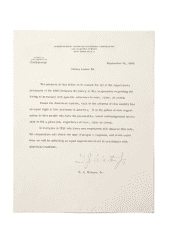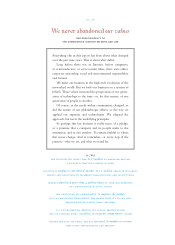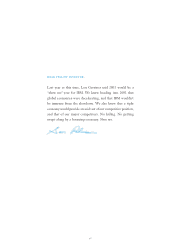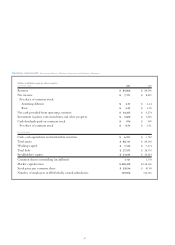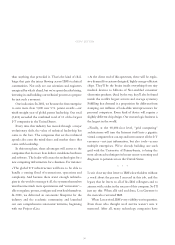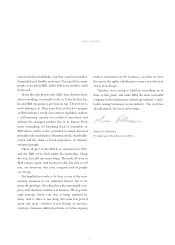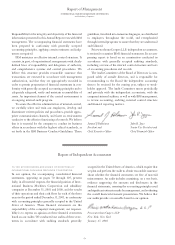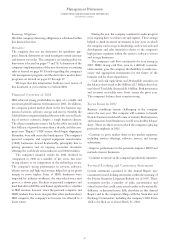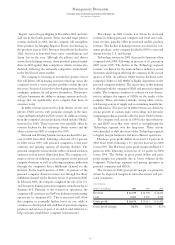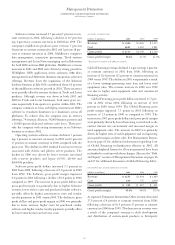IBM 2001 Annual Report Download - page 52
Download and view the complete annual report
Please find page 52 of the 2001 IBM annual report below. You can navigate through the pages in the report by either clicking on the pages listed below, or by using the keyword search tool below to find specific information within the annual report.
than anything that preceded it. That’s the kind of chal-
lenge that gets the juices flowing across IBM’s technical
communities. Not only are our scientists and engineers
energized by what’s ahead, but we’ve spent decades hiring,
investing in and building our technical prowess to prepare
for just such a moment.
One indication: In 2001, we became the first enterprise
to earn more than 3,000 new U.S. patent awards
—
our
ninth straight year of global patent leadership. Our total
(3,411) exceeded the combined total of 12 of the largest
I/T companies in the United States.
Every time this industry has moved through a major
evolutionary shift, the value of technical leadership has
come to the fore. The companies that set the technical
agenda also earn the mind share and market share that
come with leadership.
In this next phase, those advantages will accrue to the
companies that do more than deliver standalone hardware
and software. The leader will create the technologies for a
new computing infrastructure for e-business. For instance:
•The global I/T infrastructure will have to be able to
handle a coming flood of transactions, operations and
complexity. And because there aren’t enough technolo-
gists in the world to manage it all, the systems themselves
must become much more spontaneous and “autonomic”
—
able to regulate, protect, configure and even heal themselves.
In 2001, we delivered an autonomic blueprint for the
industry and the academic community, and launched
our own comprehensive autonomic initiative, beginning
with our Project eLiza.
•At the client end of this spectrum, there will be explo-
sive demand for custom-designed, highly energy-efficient
chips. They’ll be the brains inside everything from tiny
medical devices to billions of Net-enabled consumer
electronics products. (And, by the way, they’ll also be found
inside the world’s largest servers and storage systems.)
Fulfilling that demand is a proposition far different from
stamping out millions of look-alike microprocessors for
personal computers. Every kind of device will require a
slightly different chip design. Our custom logic business is
the largest in the world.
•Finally, at the 40,000-foot level, “grid computing”
architectures will turn the Internet itself into a gigantic
virtual computer that can tap and interconnect all the I/T
resources
—
not just information, but also tools
—
across
multiple enterprises. We’re already building one such
grid with the University of Pennsylvania, to bring the
most advanced techniques in breast cancer screening and
diagnosis to patients across the United States.
***
I can’t close my first letter to IBM’s shareholders without
a word about the person I succeed in this job, and the
legacy that he leaves to all of his IBM colleagues and to
anyone with a stake in the success of this company. So I’ll
just say this: When all’s said and done, Lou Gerstner is
the man who recreated IBM.
When Lou arrived, IBM’s very viability was in question.
Even those who thought we’d survive weren’t sure it
mattered. After all, many technology companies have
ceo’s letter
50


